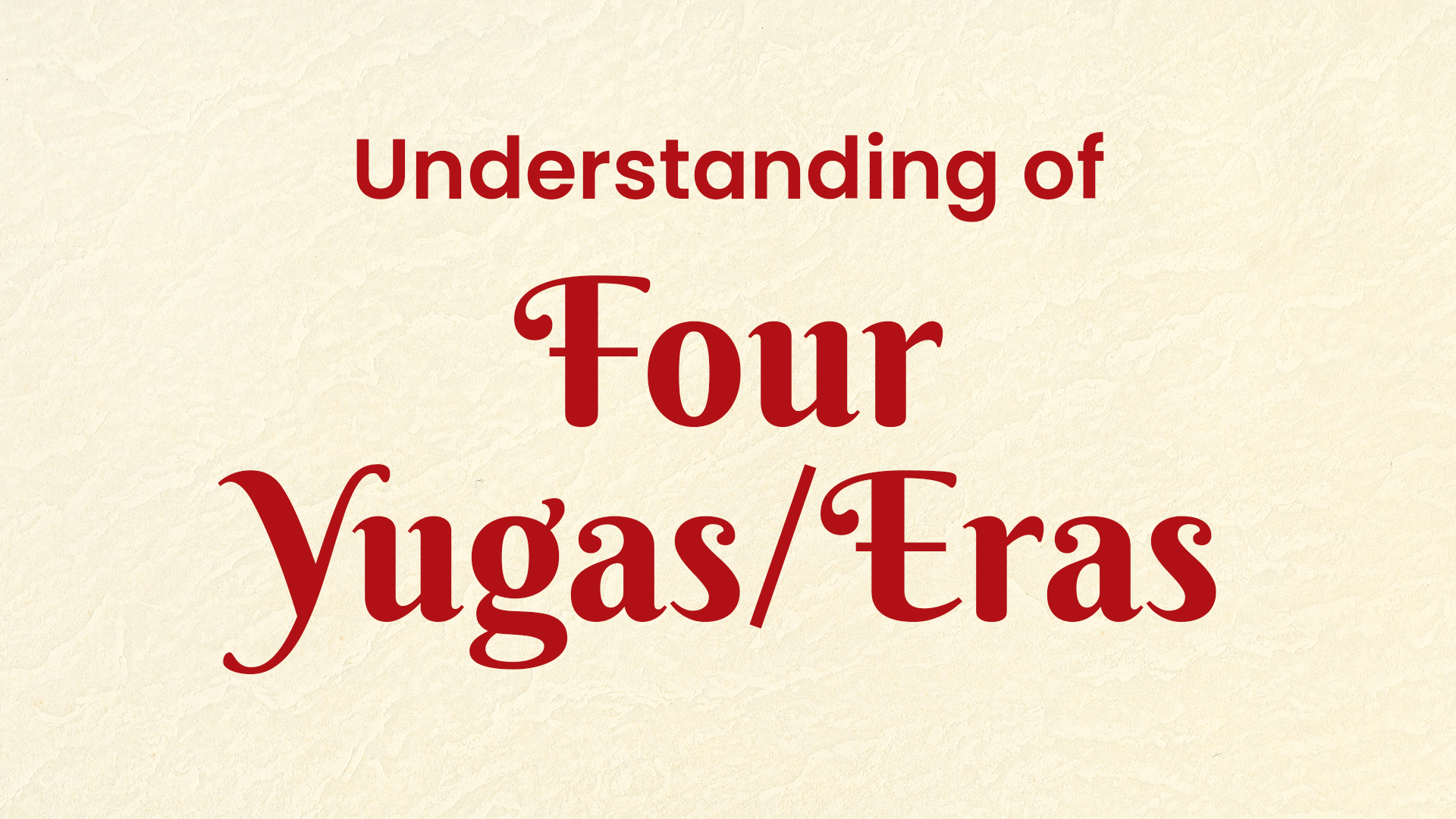Understanding of Four Yugas/Eras
चार युग की समज।
We have all heard about the existence of four Yugas in Hinduism. Yuga is considered as an age of humankind according to our Hindu mythology. A total of four Yugas form the complete cycle of creation and destruction on earth. When we talk about the time period as in years, it is important to know that the time period of human beings, the time period of deities and the time period of Brahma Lok is different. There is a story mentioned in Vinshu Puran that explains a lot about the theory of time.
There was a king named Rewat who had 99 brothers. And he had a daughter named Rewati. When Rewati grew up and became eligible for marriage, a question arose in everyone’s mind including Rewat and his brothers. Even Rewati herself thought about whom she should marry. So, they all made a list of eligible candidates for marriage. Taking that list, both Rewat and Rewati went to Brahmalok to meet Brahma Ji to ask him to select a good match for Rewati after scrutinizing the list. At the time when Rewat and Rewati reached Brahmalok, Brahma Ji was listening to the music of two Gandharvas named ‘Haha’ and ‘Huhu’. Rewat thought that he should wait for the music to be finished, so he began to wait. After sometime when the music ended, Rewat took Rewati to Brahma Ji and said, “Brahma Ji, there is confusion in all of our minds that with whom should we marry Rewati. And for that, we have made a list. So Brahma Ji, kindly guide me with whom should I get Rewati married from this list.”
As soon as Rewat said that, Brahma Ji laughed and said, “Don’t you know that the human time, the time of Gods and the time of Brahmalok are different. By the time you were waiting outside and listening to the music of Gandharvas, four Yugas have passed on earth.”
Let’s see the shloka of Vishnu Purana delineating the same:
बहूनि हि तवात्रेतद्
गान्धर्वं श्रृण्वतः
चतुर्युगा व्यतीतानि।
– विष्णु पुराण
Brahma Ji continued and said, “It’s still not too late. If you will go back now, then on earth, there will be a period of Dwapar Yuga going on. And there, you’ll find Balarama, brother of Shree Krishna, the incarnation of Lord Vishnu. You can get Rewati married to Balarama.
So, Rewat and Rewati came back to earth. But when they came back, the earth was entirely changed. There was nothing like what they left before going to Brahmalok. Many rivers had extinct and there were many buildings that had been built up. Not only that, even the height of people had reduced. After meeting Balarama, Rewati got married to him. But, as we all know that the height of people was reduced in Dwapar Yuga but the height of Rewati was very tall. So, it is mentioned in Bhagwad Purana that to reduce the height of Rewati, Balarama Ji took a plough and pressed it on the shoulder of Rewati. Rewati’s height was reduced to the appropriate height of that period. After seeing this, Rewat pleasingly walked away to the Himalayas.
Let’s see the shloka mentioned in Vishnu Purana:
दत्त्वा च कन्याम् स
नृपोजगाम हिमाचलम् वै
तपसे धृतात्मा।
– विष्णु पुराण
This story of Vishnu Purana explains a lot about time. The time of human beings, the time of gods and the time of Brahma Ji are different. And on the basis of that, the time period of four Yugas on earth is counted.
First of all, before going towards the understanding of four Yugas, it is very important to understand Kaal. To classify the types of Kaal (time), a verse has been given in Surya Siddhanta.
लोकानाम् अन्तकृत् कालः
कालोन्य कलनात्मकः।
स द्विधा स्थूल सूक्ष्मत्वात्
मूर्तश्र्च अमूर्त उच्यते।।
– सूर्य सिद्धांत
“There are two types of Time Periods (काल). One is the destroyer of the world. And the other is the measurable time period. The measurable time period is also further classified into two types:
- Gross time (स्थूल काल)
- Subtle time (सूक्ष्म काल)
Gross time is a measurable time period, so it is also called death time. But the subtle time is not measurable and that is why it is called Amrit time.”
The gross time, also known as death time or the measurable time is the one that we classify as a time period of past, present and future. Atharva Veda has given a verse for the measurable time period that we talk about.
“काले ह भूतं भव्यं चेषितं
ह वि तिष्ठते।”
– अथर्ववेद
The science of knowing this measurable time period is called Astrology. And it is also given in Vedang Jyotish.
“ज्योतिषं कालविधानशास्त्रम्।”
– वेदाङ्ग शास्त्र
Now, a verse has been given in Narada Samhita which states that astrology has three subdivisions – Siddhanta, Samhita and Hora.
“सिद्धांतसंहिताहोरारुपम् स्कन्धत्रयात्मकम्।”
– नारद संहिता
Among these three subdivisions, the Siddhanta part of astrology is also called the ‘math’ part. And in Siddhanta’s part of astrology, it is clearly described how the calculation of days, months, years, four Yugas can be done. Bhaskacharya has given a verse in the Ganit chapter of his text, Siddhanta Siromani.
त्रुट्यादि प्रलयान्त काल कलना मानप्रभेदः क्रमात्।
– भास्कराचार्य, सिद्धान्त शिरोमणि
“From the beginning of the time to end of the holocaust, all time periods (Truti, Writer, Vinadi, Nadi, Midnight, Month, Season, Ayan, Year, Satya yuga, Treta yuga, Dwapar yuga, Kali-yuga, manvantar, Brahma Ji’s day, Mrut Kaal, Amrit Kaal, 9 types of different time zones and their time differences i.e. Brahma Ji’s, Deities, Paternal, Prajapatya, Guru, Saur, Savan, Chandra & Nakshatra) are seen or calculated by the Siddhanta subdivision of Astrology.”
So, there is no medium other than Astrology for the calculation of time period. Now, let’s understand the four Yugas that are classified on the basis of qualities of the time period. And the four Yugas are Satya yuga, Treta yuga, Dwapar yuga, Kali-yuga. A verse has been given in Bhagvat Purana depicting how long is each Yuga.
कृतं त्रेता द्वापरं च
कलिश्चेति चतुर्युगम्।
दिव्यैद्वादिशभिर्वर्षेः
सावधानं निरुपतिम्।।
– भागवत पुराण
“Satya Yuga, Treta Yuga, Dwapar Yuga and Kali Yuga are the four Yugas. The total time period for all these 4 Yugas is 12000 divine years or the years of deities.”
Kali Yuga is of shortest time period i.e. 1000 divine years. Dwapar Yuga is double the time period of Kali Yuga i.e. 2000 divine years. Treta Yuga is three times the time period of Kali Yuga i.e. 3000 divine years. And Satya Yuga is four times the time period of Kali Yuga i.e. 4000 divine years. Now, if we sum up the time period of all four Yugas, then we will get the total time period of 10000 divine years. But, in scriptures, the total time period of 4 Yugas is mentioned as 12000 divine years. So, further in the scriptures, another principle has been mentioned to clarify this confusion and difference. It is mentioned that each Yuga has 10% time of evening before the beginning of an era and 10% time of the last evening that happens in the ending of an era. Let’s see the calculations according to this principle.
Kali Yuga = 1000 divine years. If we add 10% of the time period of Kali Yuga for the previous evening and 10% for the final evening, then 1000 + 100 +100 = 1200 divine years. The double the time period of Kali Yuga will be Dwapar Yuga i.e. 2400 divine years. Treta Yuga will be three times the time period of Kali Yuga i.e. 3600 divine years. And Satya Yuga will be four times the time period of Kali Yuga i.e. 4800 divine years. So, now we will get a total of 12000 divine years by summing up the time period of all four Yugas. Even if we calculate the time period by the above principle, then also we will get the same total. To explain this entire mathematical calculation, a verse has been given in Manu Smriti.
“इतरेषु ससंध्येषु
ससंध्यांशेषु च त्रीषु।
एकापायेन वर्तन्ते
सहस्त्राणि शतानि च।।”
– मनु स्मृति
Now, we know that Kali Yuga is of 1200 divine years, Dwapar Yuga is of 2400 divine years, Treta Yuga is of 3600 divine years and Satya Yuga is of 4800 divine years. Note that in the above mentioned time period, the years are mentioned as divine years i.e. years of deities. And we already know that the time period of humans and the time period of deities are different. So, to calculate the time period of Yuga in the context of human years, it becomes important to understand the correlation between the year of deities and the year of human beings.
To calculate the years of human beings in correlation with the years of deities, we will have to go through the principle of the lunar calendar. Because the Indian Vedic month is calculated by the Lunar month. As we know that the moon has two sides – Shukla Paksha and Krishna Paksha. The moon keeps on reducing for 15 days till it gets disappear and then the moon keeps on increasing for 15 days till it appears completely. And the total lunar cycle makes a month. For this, a verse has been given in Taittiriya Samhita.
चन्द्रमा वै पञ्चदशः।
– तैत्तिरीय संहिता
“One lunar month is of 30 days.
We have in total 12 lunar months. So, the Indian Vedic year is of 12×30=360 days. This is called one human year. It has been stated in scriptures that one human year is equal to one day of deities. For certainty, let’s see the verse of Taittiriya Brahman.
एकं वा एतद्
देवानामः।
यत् संवत्सरः।
– तैत्तिरीय ब्राह्मण
“360 days of human beings = 1 day of deities i.e. 1 human year = 1 divine day.
We know that 1 Kali Yuga is equal to 1200 divine years. So, 1 Kali Yuga will be equal to 1200 × 360 i.e. 432,000 human years. The double the time period of Kali Yuga will be Dwapar Yuga i.e. 864,000 human years. Treta Yuga will be three times the time period of Kali Yuga i.e. 1,296,000 human years. And Satya Yuga will be four times the time period of Kali Yuga i.e. 1,728,000 human years. So, we will get the total of 43,20,000 human years by summing up the time period of all four Yuga and this combined time period of four Yugas is known as Maha Yuga. It has been said by experts that a holocaust occurs after the completion of a cycle of 1000 such as Maha Yuga i.e. after 4 billion 32 crores human years.
This entire mathematical principle is explained in a simplified verse of Atharvaveda.
शतं तेऽअयुतं हायनान् द्वे
युगे त्रीणि चत्वारि
कृण्मः।
– अथर्ववेद
“We can get the knowledge of the time period of Yuga by adding 432 to 100 Ayuts. Ayut means 10000.
Thus, 100 Ayuts = 100 × 10000 = 1 million. And if we put the numbers 432 before 1 million, then we get 4 billion 32 crores.
So, by any of the above two principles, it is clear that the time period of earth before the holocaust is 4 billion 32 crores human years.
In 2022 i.e. the present year, Kali Yuga is in its first phase. And according to the calculations, it has been mentioned in scriptures that it’s only been 5122 years since Kali Yuga has begun. We know that the total time period of Kali Yuga is 432000 years. So, there are still many years left for the end of Kali Yuga.
There is a question that has been constantly asked by the people. Has Kalki, the avatar of Lord Vishnu already taken birth on this earth? The answer is no. The last avatar of Lord Vishnu, Kalki is not born yet. It is clearly mentioned in all the ancient scriptures that the Kalki Avatar will be born at the end of Kali Yuga. And it’s still 426,878 years left for the Kali Yuga to get an end. So, there is no possibility of Kalki avatar being born in the present years.
By now, you might have probably understood the measurable time period i.e. Mrut Kaal. But, there is another time period that cannot be objectified. It’s a subjective time and it may vary from person to person. An amazing verse has been given in Aitariya Brahman to explain this subjective time period.
कलिः शयानों भवति
संजिहानस्तु द्वापरः।
उत्तिष्ठन्त्रेता भवति कृतं
संपद्यते चरन्।।
– एतेरेय ब्राह्मण
“When a person lives in an ignorant way or stays inactive, he is said to be living in Kali Yuga. When a person lives in a conscious condition and analyzes his surroundings, he is said to be living in Dwapar Yuga. When a person wakes up from his unconscious mind, start to understand the depth of the matter, start taking conscious decisions and become tend to understand the truth, then he is said to be living in Treta Yuga. Lastly, when a person starts walking on the path of truth and becoming inclined to get what he wants, then he is said to be living in Satya Yuga i.e. the golden era.”
This is the meaning of subjective time period. We cannot choose the era we were born in but we can definitely choose the era we want to live in. The Yuga of our birth period cannot be changed but it’s upon us how we live our lives and according to which Yuga we live our lives. So, if you wish to live in the golden period of life, stay committed to what you want in life, remember to stay true to yourself and always follow the path of truth.
Shubham Bhavatu
शुभम् भवतु।









Comment (1)
Lupe Moppin
December 14, 2023 at 10:18 pmSome genuinely fantastic information, Glad I observed this.